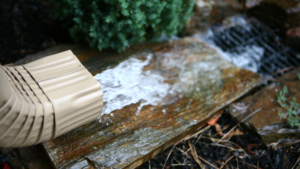Are you experiencing water flowing everywhere but down your gutters? Gutter overflow is a common problem for homeowners everywhere. Fortunately, it is easy to fix once the source of the overflow has been identified. You are likely experiencing one of the following overflow causes; read on to learn more.
Clogged Gutters
The most common reason why a gutter would overflow is that it is clogged. Debris of all sorts, from leaves to loose sediment, can end up in your gutters—all it takes is one twig to cause a blockage and a clog to form. When the rain comes, it has nowhere to go and ends up spilling over the sides. The easiest way to fix this problem is to clean out the gutters and ensure no clogs remain.
Gutter Pitch Overflow
Installing gutters isn’t as simple as it seems; it is a combination of physics and geometry. Essentially, water has to flow down off the roof and into the gutters, but it might need to take a specific route to get there. Once the water reaches the end of the roof, there is a transition point into the gutters. If the gutters aren’t pitched in the correct position, you will likely see the water going over the end cap. The way to fix this is to simply have your gutters re-pitched.
Loose Gutter Overflow
Again, your gutters are pitched in the perfect place to accept the oncoming water. However, your gutters may become loose over time due to age or damage. If they become loose, the water won’t cascade into the gutters at the correct angle, putting it over, behind, or every which way except where it should be going. To fix this, the gutters will need to be tightened, repaired, or replaced.
Over the Gutter
Does your roof water look like it is sailing straight over the gutters? If the water is actually going over the gutters, there could be a number of reasons why.
1. The water flow from roofing valleys or seams is too much for your gutters to take at once. You may need to add splash guards or upgrade your gutter size.
2. Your roof pitch is too steep for your gutters. Installing gutter wedges may help achieve the appropriate angle.
3. Roof shingles hang too far over the roof’s edge, acting as a ramp for the water to jump the gutter. You will need to remove the shingles (if possible), get gutter wedges, or upsize your gutters.
4. Added gutter covers are blocking the rain. You may need to add splash guards or remove the covers.
5. An obstruction is blocking the channel in the gutter. It just needs to be removed.
Behind the Gutter
It can be challenging to tell if water is going behind your gutters, but it is a severe problem because it can cause your trim board to rot if exposed to too much water. Fortunately, once identified, it is usually due to one of the following problems:
1. Clogged gutters
2. Loose gutters
3. Incorrect gutter pitch
4. Drip edge issues
Entire System Overflow
If your entire gutter system appears to be overflowing, there is a major problem somewhere in your system. It may be as simple as a loose gutter system or incorrect pitch. However, the most likely problem is clogs in every downspout or a clog in your underground drains. We recommend flushing out all drains and downspouts to eliminate any clogs. If you still have problems after, you should call a professional roofer to inspect your roof and identify the exact problem.


